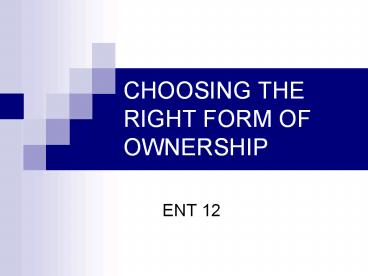CHOOSING THE RIGHT FORM OF OWNERSHIP - PowerPoint PPT Presentation
1 / 11
Title:
CHOOSING THE RIGHT FORM OF OWNERSHIP
Description:
harder to raise capital than for a partnership ... to work together to achieve the objectives of a business venture. ... especially for startup losses ... – PowerPoint PPT presentation
Number of Views:12
Avg rating:3.0/5.0
Title: CHOOSING THE RIGHT FORM OF OWNERSHIP
1
CHOOSING THE RIGHT FORM OF OWNERSHIP
- ENT 12
2
WHAT ARE THE CHOICES?
- A new venture can be established as
- a sole proprietorship
- a partnership
- or a corporation
3
SOLE PROPRIETORSHIP
- Only one owner who is entitled to all profits and
responsible for all liabilities - Owner assumes unlimited liabilityif it is in
financial trouble, the owners personal assets
can be used to cover any business debts
4
ADVANTAGES DISADVANTAGES
quick, easy, and inexpensive to establish limited in terms of employee compensation plans
only requires registration and appropriate licenses all business income is taxable
owner makes all decisions profits may be taxed at a higher rate than for an incorporated organization
owner includes all business profits/losses with personal income harder to raise capital than for a partnership or a corporation
5
PARTNERSHIP
- A formal commitment between two or more people to
work together to achieve the objectives of a
business venture. - All partners may or may not be actively involved
in the day-to-day operation of the venture. - Partners share profits and losses according to
the percentages laid out in their partnership
agreement. - Each partner contributes something toward the
partnership startup money, material resources,
talent, skill, experience, knowledge, or business
contacts.
6
Types of Partnerships
- A general partnership is registered in the same
way as a sole proprietorship. Profits or losses
are divided according to each partners
percentage of interest or ownership in the
venture and are applied to personal income for
tax purposes. All debts and obligations,
regardless of whose responsibilities they were,
are the responsibility of each partner. If in
bankruptcy one partner does not have enough
personal assets to cover his or her share of the
losses, creditors can file claims on the personal
assets of any of the other partners in the joint
venture.
7
Types of Partnerships continued
- A limited partnership consists of one or more
partners whose liability is limited to the amount
they invested in the venture. Silent partners,
who invest money in the partnership but do not
take an active part in the management of it, may
also be involved in a limited partnership.
8
Partnership Agreement
- The partnership agreement is a legal document
that allows members of a partnership to establish
rules for their relationship and to specify the
conditions that will cause the partnership to
dissolve. This agreement may include - initial contribution made by each partner
- roles and responsibilities of partners
- amount each partner may withdraw
- procedures for distributing profits/losses,
dealing with death of partners, selling or
liquidating the partnership, appointment of
authorized persons for signing cheques and other
documents, dealing with disagreements
9
ADVANTAGES DISADVANTAGES
quick, easy, and inexpensive to establish general partners assume unlimited liability for all debts/obligations incurred by the partnership
each partner may deduct business losses (in proportion to the amount invested in the business) from whatever is earned within the business both business and personal income are taxed
favourable tax treatment, especially for startup losses profits may be taxed at a higher rate than for an incorporated organization
combines the talents and resources of two or more people unless otherwise stated in a partnership agreement, the partnership is automatically dissolved when one of the partners dies
if the partners cant agree on the day-to-day operation of the partnership, decisions become difficult to make
10
CORPORATION OR LIMITED COMPANY
- A corporation or limited company is a legal
entity created by law, and established by
corporate charter, that stands apart from the
people who own it. - The corporation is able to enter agreements, own
land and property, and hold contracts. - It can be sued and incur debts.
- A corporation is a limited company because the
liability of the shareholders or owners is
limited to the amount of money that they
originally invested in the corporation (or what
they paid for the shares they purchased). - A corporation is often managed by a board of
directors, which is elected by the shareholders.
The board then appoints the president and other
executives. - Profits are given out to shareholders based upon
the number of shares each person holds. - When a corporation files the appropriate
documents and gets approval to go public the
shares can be publicly traded on a stock
exchange. - Personal assets of shareholders cant be claimed
to cover debts or obligations that the
corporation incurs.
11
ADVANTAGES DISADVANTAGES
corporations have an unlimited life, so day-to-day business continues despite the illness or death of their owners more costly to set up because of government fees, name searches, legal fees
ownership is easily transferred requires more formal annual activities (annual meeting, minutes, report)
profits can be removed from the corporation in the form of dividends, which can be a tax benefit to the owner losses cannot be used by the owner to offset personal income
the corporation can arrange for employee benefits such as group insurance or registered pension plans owners personal assets can still be seized by the lending agency if he or she has put up personal collateral for a business loan































